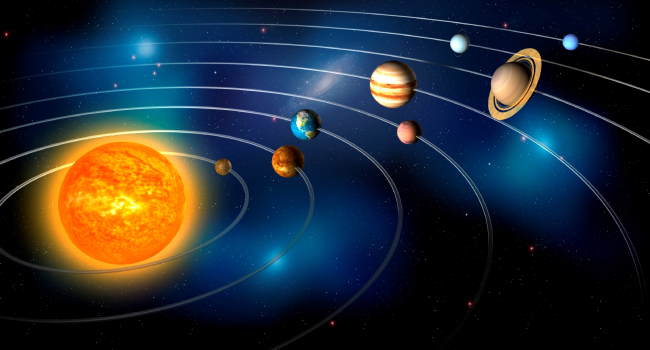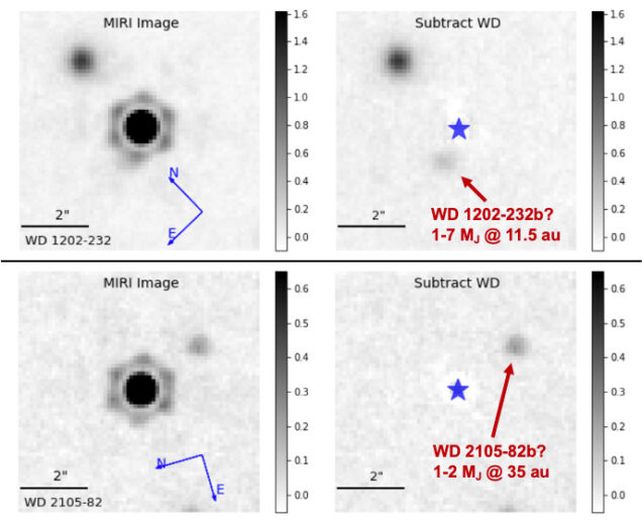
What will happen to Earth and other planets in Solar System when Sun's light goes out?
Scientists have concluded that dying stars can trigger eruptions and eject massive masses into space. This applies to the Sun as well, which in the future will turn into a red giant, stretching up to Mars, before it catastrophically loses its outer shell, and its core collapses, transforming into a super-dense white dwarf.
However, what will happen to Earth and other planets after the Sun's demise? Will they wander through the Galaxy due to the disruption of their orbits, or will they fall into the embrace of the white dwarf? Is it possible that these planets will continue to peacefully orbit the spent star as it slowly cools over billions of years? A recent discovery may help answer these questions and reveal the potential fate of the Solar System.
Using the James Webb Space Telescope (JWST), astronomers have been able to capture direct images of two gas giant exoplanets orbiting white dwarfs. "In case of confirmation," writes a group led by astronomer Susan Mallalali from the Space Telescope Science Institute (STScI), "these will be the first direct images of planets that are similar in age and distance to giant planets in our Solar System, demonstrating that giant planets like Jupiter can survive during stellar evolution."
Typically, exoplanets cannot be observed directly. Currently, there is confirmation of over 5500 exoplanets, with thousands more candidates identified, but most of these discoveries have been indirect. Astronomers observe the impact of a planet on the brightness of a star during its transit in front of the telescope's view, and based on this data, they draw conclusions about the planet's properties.

Directly detecting exoplanets is very challenging due to their small size and the vast difference in the amount of light emitted by exoplanets and stars. However, the James Webb Space Telescope is the most powerful telescope among space observatories, enabling astronomers to detect giant exoplanets orbiting two white dwarfs — WD 1202-232 and WD 2105-82, located at distances of 34 and 53 light-years from Earth, respectively. Currently, the masses of these planets are unknown, but the images indicate that their mass may be 1-7 times that of Jupiter. More accurate results may be obtained in the future.
What's even more intriguing is the orbital distance between white dwarfs and their planets. The first exoplanet, orbiting WD 1202-232, is located at a distance of 11.47 astronomical units — slightly more than Saturn, which orbits the Sun at a distance of 9.5 astronomical units. The second exoplanet, orbiting WD 2105-82, has an orbital distance of 34.62 astronomical units, comparable to Neptune's orbital distance of 30 astronomical units.
This discovery may suggest that exoplanets with orbital distances similar to the outer planets of the Solar System can survive after the catastrophic death of their stars and remain in their orbits.
At the moment, a small number of exoplanets around white dwarfs have been discovered, and scientists have limited information that could help predict the fate of the Solar System. It is known that white dwarfs can consume nearby planets, as confirmed by the analysis of their atmospheres.
The discoveries of the JWST are not yet confirmed — the two objects could be background galaxies, although researchers consider this unlikely. These two candidate planets will become an essential part of the story of what happens to a planetary system when a star reaches the end of its life cycle.
Scientists intend to continue additional research to determine the nature of these planets and gather additional data: "If we receive confirmation, these giant planets will become the first planets discovered by direct imaging that are similar in age, mass, and orbital distance to giant planets in our Solar System."
- Related News
- Wheel of Death: new method will help astronauts stay fit in low gravity
- Due to anomalies of Orion spacecraft, lunar exploration program may be delayed for years։ NASA
- TAO Observatory: World's highest telescope to study evolution of galaxies and exoplanets
- Powerful M9.5 solar flare causes radio blackout in Pacific Ocean
- What will happen to the Earth if the Moon disappears?
- Key to conquering the Red Planet: Why is NASA studying solar storms on Mars?
- Most read
month
week
day
- Digital Julfa Network is launching a pan-Armenian centre in the metaverse, on the Fastexverse virtual platform 1002
- Xiaomi unveils exclusive Redmi Note 13 Pro+ dedicated to Messi and Argentina national team 880
- Sparkles: Boston Dynamics unveils a furry robot dog that can dance (video) 834
- Is there a ninth planet in the solar system? Scientists find new evidence 707
- Internet 500 times faster than 5G tested in Japan: It allows to transfer five movies in HD resolution in one second 700
- What will happen to the Earth if the Moon disappears? 693
- Smartphone catches fire in child's hand in Russia 677
- iPhone 16 may get colored matte glass back panel, 7 colors 672
- How to understand how protected a smartphone is from water and dust? 670
- World's largest 3D printer was created in USL It prints 29 meter-long structures 657
- Archive
